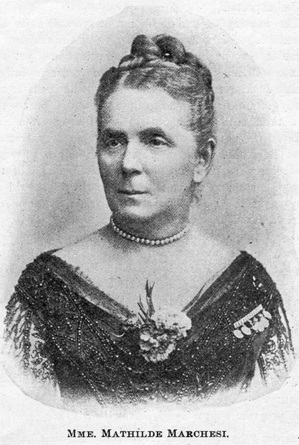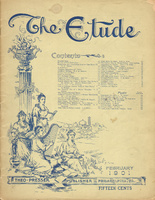In reveiwing (sic) our work I find an apparent inconsistency between the title and the part of the subject promised for this number. This can be qualified by recalling that we are working in the interest of the teacher, and the teaching repertory may well include studies and all that can be of service as studio-equipment. To proceed, the names of the Marchesi’s are well and honorably known in the realm of music; but, for reasons quite unusual, both appear in the system we are outlining for teachers, and we shall speak of them in the order of their importance as affecting its development. Were it not for one humble effort at book-making for the student, Salvatore Marchesi might have been known in America only as the husband of his gifted wife.
Salvatore Marchesi.
He was a scholarly and accomplished scion of the Italian nobility, who abandoned his studies of law and philosophy to pursue the more attractive study of music. He had an excellent baritone voice, which stood him well in need, for when, for political reasons, he was banished, he found refuge in America, where he made his début as an opera singer in 1848 or 1849. It was in 1852 that he married Fraülein Graumann, and together they have wrought to the exalted ends of vocal and dramatic art.
While Salvatore Marchesi is widely known in Europe as an Italian translator of libretti (notably those of “Tannhaüser” and “Lohengrin”), as a writer of German and Italian Songs, an authority on special vocal literature, a teacher and artist, his reputation here rests solely on the twenty vocalizes which, in the sequence we are suggesting, follows the “Sieber Studies” mentioned in our last issue. This book is as valuable as it is unique. It is the second successful effort that has ever been made to place before students a study of all the embellishments in a practical and attractive form. Vaccai was his predecessor in this effort, and the works are equally useful, the Vaccai book being more difficult and on a higher musical plane.
The twenty vocalizes of Marchesi are invaluable to the student. An entire lesson is devoted to each subject, of which there are eighteen, the twenty being made up by the addition of two résumés, or reviews. These subjects are presented with such clearness that, after having passed the book carefully, we can hardly be surprised by the appearance of any of the groupings of notes, scales, or graces which abound in the classics, especially in the compositions of Mozart, Rossini, and the older Italian writers. They appear in easy compass, are of moderate difficulty, and set to an Italian text that is neither difficult nor of particular importance, except as the most natural vehicle for studies of this kind. It is highly important that at this point in vocal work the embellishment be fully mastered, and there is no method for this purpose equal to the song form which Salvatore Marchesi has used with such success. The book is found in every studio and in the catalogues of nearly every publisher. There are now but few copies in existence as Marchesi originally prepared them. Arrangements, translations, recutting of plates, attempts to improve them, etc., have fastened upon the books as they now appear twelve or fifteen radical changes.
 Mathilde Marchesi.
Mathilde Marchesi.
It is deeply to be regretted that the balance that usually accompanies maturity is wanting in Madame Marchesi, and the lustre of great attainment is dimmed by her inability to yield graciously to the amenities of increasing years.
This remarkable woman, whose maiden name was Graumann, was thrown upon her own resources at the age of 23, by financial reverses in her family, and adopted music as her means of support. She was born in 1826, at Frankfort-on-the-Main, and is now living at the ripe age of 75.
Her first teacher was Nicolai, at Vienna, but in 1845 she went to Paris to study with Garcia, and it was here that her aptitude for teaching declared itself and was so pronounced that Garcia, who became incapacitated for teaching by an accident, gave her his entile class to carry until he was able to resume. Thus began the career of a woman who has given more artists to the stage than any living teacher of singing, of whom Rossini said: “Her method is a true exposition of the art of the Italian school of singing,—inclusive of the dramatic element.”
After singing successfully in the principal cities of Europe she returned to her calling as a teacher by accepting the post as professor of singing at the Vienna Conservatoire.
We will not follow her in her succeeding appointments, but review her work and its influence upon the singer.
Fame may be subdivided into two groups,—one the fame which enjoys the homage of contemporaries, with its attendant advantages; and, the other, enduring fame, which may be said to look to posterity to determine whether it possesses this essential quality.
Enduring fame depends largely upon the creative instinct for its existence. Singers, except in very rare instances, are rewarded only by contemporaneous fame. Upon nearly every page of Grove’s “Dictionary” we may find mention of artists who once thrilled the musical world with their wondrous singing, but can we call that fame?—The message has been delivered, the voice is silent. The art displayed was only the individual quality, all passed with the singer. The fact of having once been an artist, with a few facts incidental thereto, can hardly be said to vitally concern posterity. The thought that lives again and finds its response in the expanding minds of every succeeding generation marks for its author a thing which, indeed, is fame. Can we identify Mathilde Marchesi with this group? If so, it will not be because she was a great singer or teacher, but because she had the creative and fashioning instinct. Her splendid compilation and classification of the best exercises of the old Italian school into convenient form for use, and her scholarly productivity in the field of composition for specific needs, will win sincere gratitude on the part of teachers and students, long after the author and her singers have been forgotten.
Madame Marchesi has given to the world twenty- five books of exercises. In them she has comprehended the needs of the female voice in all of its variety. One can hardly suggest a quality, an embellishment, a color, a shade of thought or dramatic incident, that has not been treated in a masterful way in her books.
The musicianly accompaniments, the graceful melodic and harmonic combinations so dear to students, are the chief characteristics of her writings. They may sing while they work. What can be more inviting?
Our American teachers know and make but little use of Marchesi’s compositions for the studio; her agility studies are well known, but her melodic vocalizes have yet to be commonly used and appreciated.
I advise teachers to give them a careful examination.



